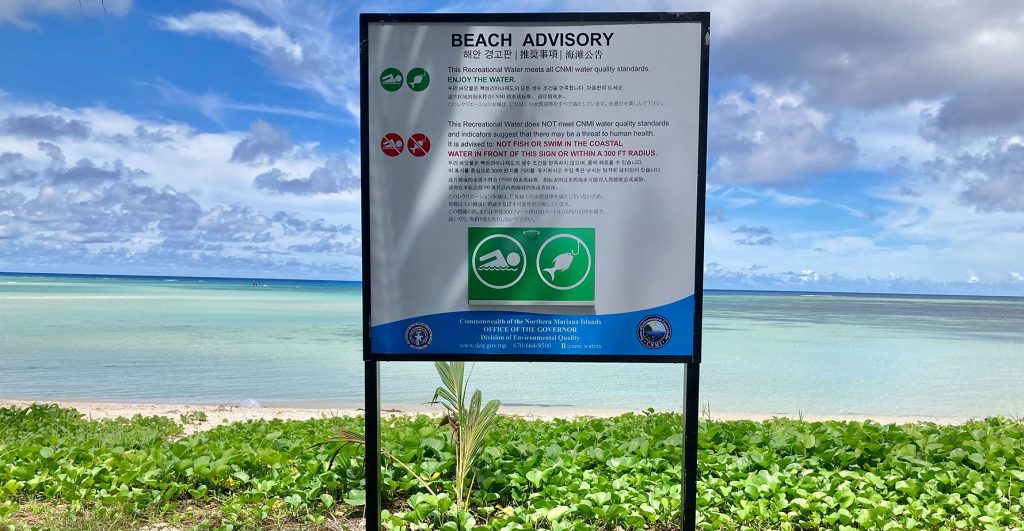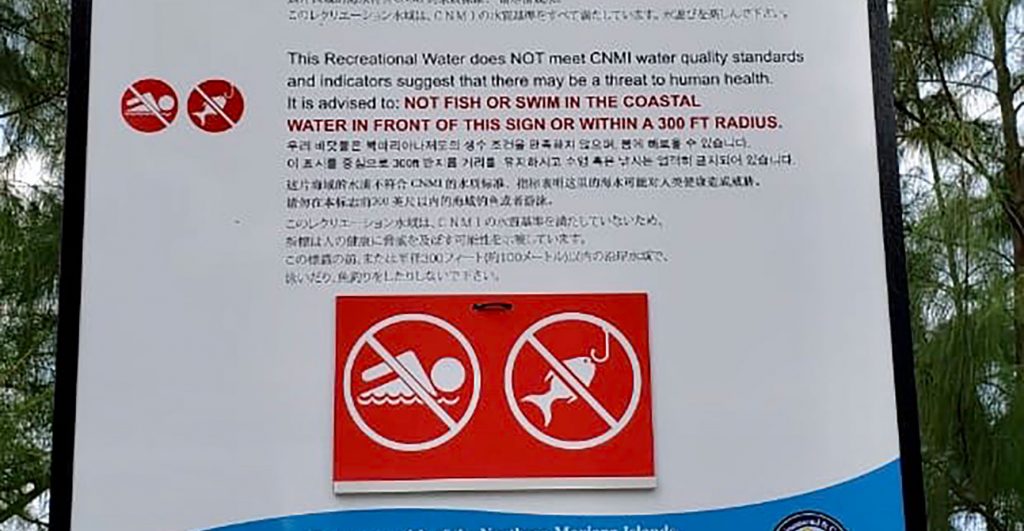Are you going to the beach today?
Check out the beach flags and stay safe

Going swimming or fishing? Check out the beach signs put up by the Bureau of Environmental and Coastal Quality to protect public health, as they sample beaches and coastal areas in the CNMI for bacteria concentration. Green flag on the beach means it is safe for swimming and fishing, whereas a red flag on the beach cautions us for it may not be safe to do such activities. (IVA MAURIN)
Are you heading to the beach today? Make sure to check out the beach signs to see if it is safe for you to swim or go fishing.
Have you ever found yourself going to the beach, swimming your heart out, only to have rashes and get all itchy later? That is what the beach flags are for, as an advisory for all of us that the water quality on a particular site has gone over standard levels that makes it unsafe to swim or fish in that area, at least for 48 hours.
We only have to watch out for two kinds of flags: A green flag is for when it is safe for us to swim or fish, and a red flag is the opposite, when the water quality sample from a beach site exceeds advisory levels, meaning, it may be unsafe to swim or fish within 300 feet of the posted signs.
Just this month alone, so many sites got “red flagged,” including the West Harbor Marina, Talakhaya Beach, Garapan Fishing Dock, Garapan Beach, Bird Island, Smiling Cove Marina, Chalan Laulau Beach, Hidden Beach, Old Man by the Sea, and the Grotto (despite being closed to the public).
The beach signs are there to help protect us. The Division of Environmental Quality of the Bureau of Environmental and Coastal Quality regularly samples the beaches and coastal areas in the CNMI for bacteria concentration, and then advises us, through the beach flags, to make sure we are all safe.
BECQ samples 85 locations throughout the whole CNMI, including 12 beach sites on Rota, 10 on Tinian, 11 on Managaha, and then the rest, on Saipan.
Where are the beach flags?
Currently, there are 12 sites on Saipan that has the physical beach flag signs, but weekly beach flag advisories, covering all the other sites, are posted on social media, in the news, and on the DEQ website (http://www.deq.gov.mp).
Physical beach advisory signs are placed at the most frequented, highest-used beach areas on island—Grotto, Tanapag Meeting Hall, DPW Channel Bridge (Lower Base), Micro Beach, Grandvrio Hotel, Garapan Fishing Base, Garapan Beach (13 Fishermen’s Memorial), Civic Center Beach, Sugar Dock, CK District No. 2 Drain (Aquarius Beach), and Kanoa Resort.
All these 12 beaches get sampled weekly. DEQ samples the west side of Saipan and the Grotto weekly, with the rest of the others sites on an eight-week rotational sampling schedule—where every eight weeks, sites are shifted from monthly to weekly.
Unfortunately, BECQ currently does not have the staff nor the laboratory capacity to sample every site. Despite that, they would resample more than once if they see very high bacteria levels on a site. Resampling is done 48 hours after the first sample, to see if another red flag should be issued at that site.
Protecting public health
A red flag happens when samples taken from the beach are analyzed and are found to have exceeded CNMI water quality standards, which are based on U.S. Environmental Protection Agency recommended criteria for bacteria.
Samples taken at the beach are analyzed at the BECQ laboratory to see if they exceed standards. DEQ has a criteria adopted for enterococci, which is a fecal indicator bacteria, and sampling results are compared to the said criteria to determine if standards have been exceeded.
If standards are exceeded, BECQ issues an advisory for the public not to swim nor fish in that area within 300 feet of the sampling location, for 48 hours.
Fecal indicators could be from any animal, as enterococci is usually present in animal feces. However, DEQ clarifies that there are some small amounts of enterococci present naturally in the environment.
There are organisms in the water, thousands of different types of bacteria in the water, naturally occurring enterococci that is not necessarily linked to the presence of feces. When enterococci occurs naturally, rarely does it cause red flags, as usually they are at levels below the set criteria levels.
BECQ water quality surveillance program manager Larry Maurin explains that the bureau assesses bacteria levels according to the designated uses under the Clean Water Act, one of which is recreation. When the criteria is developed, it’s the level on what would make people sick, in reference to skin contact.
There’s a red flag! What can we do?
“General best practices at the beach is don’t go swimming after heavy rainfall, because the runoff is what causes most of the pollution. If you see the water is brown in color, or there’s been heavy rainfall, you may not want to swim there and go fishing until the waters clear. It’s pretty much common sense. If the water smells, or it’s not clear, you should consider not going there.”
The most common things that happen when people come in contact with water polluted by bacteria are stomach illnesses, ear, nose, and eye infections, skin infections, rashes, itchiness, and even respiratory problems.
“Just be aware of the environment. We don’t close beaches, we’re just trying to inform people so they can keep their families safe and healthy.”
Everyone is also encouraged to use good practices and work with BECQ and other agencies to try to improve water quality in the CNMI.
“We’re not just sampling the water and getting the results, we’re trying to work to address the causes of the water quality impairments and improve them. We encourage the public to get involved in that process, and be educated about it, engage with us on these issues, and work with or talk to their legislators.”
Get updated on beach advisory by signing up on the email list via waterqualityreport@becq.gov.mp or by contacting BECQ’s Water Quality Surveillance/Nonpoint Source branch at 664-853.
























